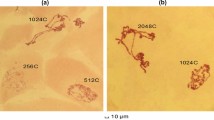Abstract
In Drosophila gibberosa the maximum secretory output of the salivary glands is in the prepupa rather than in the late third-instar larva. Using salivary chromosome maps provided here we have followed puff patterns from late second-instar larvae through the time of histolysis of the salivary glands 28–32 h after pupariation and find low puff activity correlated with low secretory activity throughout much of the third larval instar. Ecdysteroid-sensitive puffs were not observed at the second larval molt but do appear prior to pupariation initiating an intense cycle of gene activity. The second cycle of ecdysteroid-induced gene activity a day later, at the time of pupation, appears somewhat damped, especially for late puffs. Salivary chromosome maps provided here may also be used to identify homologous loci in fat body, Malpighian, and midgut chromosomes.
Similar content being viewed by others
References
Akam ME, Roberts DB, Richards GP, Ashburner M (1978) Drosophila: the genetics of two major larval proteins. Cell 13:215–225
Ashburner M (1967) Patterns of puffing activity in the salivary gland chromosomes of Drosophila. I. Autosomal puffing patterns in a laboratory stock of Drosophila melanogaster. Chromosoma 21:398–428
Ashburner M (1972) Patterns of puffing activity in the salivary gland chromosomes of Drosophila. VI. Induction by ecdysone in salivary glands of Drosophila melanogaster cultured in vitro. Chromosoma 38:225–281
Ashburner M (1974) Sequential gene activation by ecdysone in polytene chromosomes in Drosophila melanogaster. II. The effects of inhibition of protein Synthesis. Dev Biol 39:141–157
Ashburner M, Berendes HD (1978) Puffing of polytene chromosomes. In: Ashburner M, Wright TRF (eds) The genetics and biology of Drosophila. Academic, New York pp 315–395
Ashburner M, Richards G (1976) The role of ecdysone in the control of gene activity in the polytene chromosomes of Drosophila. In: Lawrence PA (ed) Insect development. Blackwell, Oxford, pp 203–225
Baker WK (1959) Permanent slide of salivary and ganglion chromosomes. DIS 26:15a
Becker HJ (1959) Die Puffs der Speicheldrüsenchromosomen von Drosophila melanogaster. I. Beobachtungen zum Verhalten des Puffmusters im Normalstamm und bei zwei Mutanten, giant und lethal-giant larvae. Chromosoma 10:654–678
Beermann W (1972) Chromomeres and genes. In: Beermann W (ed) Developmental studies on giant chromosomes. Springer, New York, pp 1–31
Berendes HD (1967) The hormone ecdysone as effector of specific changes in the pattern of gene activities of Drosophila hydei. Chromosoma 22:274–293
Bodenstein D (1950) The postembryonic development of Drosophila. In: Demerec M (ed) Biology of Drosophila. John Wiley, New York, p 349
Bridges CB (1935) Salivary chromosome maps. J Hered 26:60–69
Clever U, Romball CG (1966) RNA and protein synthesis in the cellular response to a hormone, ecdysone. Proc Natl Acad Sci USA 56:1470–1476
Dobzhansky T (1957) The X-chromosome in the larval salivary glands of hybrids of Drosophila insularis and Drosophila tropicalis. Chromosoma 8:691–698
Fraenkel G, Brookes VJ (1953) The process by which the puparia of many species of flies become attached to a substrate. Biol Bull 105:442–449
Grace TDC (1962) Establishment of four strains of cells from insect tissues grown in vitro Nature 195:788–789
Grossfield J (1971) Geographic distribution and light-dependent behavior in Drosophila. Proc Natl Acad Sci USA 68:2669–2673
Korge G (1975) Chromosome puff activity and protein synthesis in larval salivary glands of Drosophila melanogaster. Proc Natl Acad Sci USA 72:4550–4554
Korge G (1977) Larval saliva in Drosophila melanogaster: Production, composition and relationships to chromosome puffs. Dev Biol 58:339–350
Kraminsky GP, Clark W, Estelle M, Gietz R, Sage B, O'Connor JD, Hodgetts RB (1980) Induction of translatable mRNA for dopa decarboxylase in Drosophila: An early response to ecdysterone. Proc Natl Acad Sci USA 77:4175–4179
Lewis EB (1960) A new standard food medium. DIS 34:117
Mitchell HK, Lipps LS, Tracy UM (1977) Transcriptional changes in prepupal hypoderm in Drosophila melanogaster. Biochem Genet 15:575–587
Mukherjee AS, Beermann W (1965) Synthesis of ribonucleic acid by the X chromosomes of Drosophila melanogaster and the problem of dosage compensation. Nature 207:785–786
Nicoletti B (1959) An efficient method for salivary-gland chromosome preparations. DIS 33:181–182
Patterson JT (1943) The Drosophilidae of the southwest Univ Texas Publ 4313:7
Richards G (1980) Ecdysteroids and puffing in Drosophila melanogaster. In: Hoffman JA (ed) Progress in ecdysone research. Elsevier, New York p 363
Stevens B, O'Connor JD (1982) The acquisition of resistance to ecdysteroids in cultured Drosophila cells. Dev Biol 94:176–182
Throckmorton LH (1962) The problem of phytogeny in the genus Drosophila. Univ Texas Publ 6205:207–343
Velissariou V, Ashburner M (1980) The secretory proteins of the larval salivary gland of Drosophila melanogaster. Cytogenetic correlation of a protein and a puff. Chromosoma 77:13–27
Wharton LT (1943) Analysis of the metaphase and salivary chromosome morphology within genus Drosophila. Univ Texas Publ 4313:282–319
Whitten JM (1976) Possible transfer of salivary secretion to midgut at the time of pupation in Diptera Cyclorrhapha. Ann Ent Soc Am 69:273–274
Author information
Authors and Affiliations
Rights and permissions
About this article
Cite this article
Roberts, P.A., MacPhail, L.A. Structure and activity of salivary gland chromosomes of Drosophila gibberosa . Chromosoma 92, 55–68 (1985). https://doi.org/10.1007/BF00327245
Received:
Revised:
Issue Date:
DOI: https://doi.org/10.1007/BF00327245




